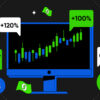
Forex (foreign exchange) and stocks are two popular investment markets that offer opportunities for traders and investors to profit from market movements. Each market has its own characteristics, advantages, and risks. In this article, we will delve into the top differences between forex and stocks and provide insights into how to effectively trade them.
1. Market Nature:
– Forex Market: The forex market involves the trading of currencies from around the world. It operates 24 hours a day, five days a week, due to its decentralized nature. Traders speculate on the price movements of currency pairs, such as EUR/USD or GBP/JPY.
– Stock Market: The stock market represents ownership in companies. It operates during specific market hours and is divided into various sectors. Investors can buy and sell shares of companies to profit from their performance.
2. Market Hours:
– Forex Market: Since the forex market operates globally, it is open 24 hours a day. This provides traders with flexibility in terms of when they can trade, catering to various time zones.
– Stock Market: The stock market operates during specific hours, usually from 9:30 AM to 4:00 PM (local time) on trading days. After-hours trading is also available but typically has lower liquidity.
3. Liquidity:
– Forex Market: The forex market is one of the most liquid markets globally, with a daily trading volume exceeding $6 trillion. This high liquidity ensures that traders can easily enter and exit positions without significant price fluctuations.
– Stock Market: Liquidity varies among stocks, with some highly traded stocks being very liquid and others having lower liquidity. This can affect the ease of buying and selling shares.
4. Leverage:
– Forex Market: Forex trading allows for higher leverage, which means traders can control larger positions with a smaller amount of capital. However, high leverage can amplify both profits and losses.
– Stock Market: Leverage in the stock market is generally lower compared to forex. Regulations often limit the degree of leverage available to traders.
5. Market Analysis:
– Forex Market: Traders in the forex market rely on technical and fundamental analysis to predict currency movements. Economic indicators, geopolitical events, and central bank policies influence forex prices.
– Stock Market: Stock traders analyze a company’s financials, industry trends, and macroeconomic factors to make informed investment decisions.
How to Trade Forex and Stocks Effectively:
– Education: Understand the market fundamentals, terminology, and trading strategies for both forex and stocks.
– Risk Management: Use proper risk management techniques to protect your capital. This includes setting stop-loss and take-profit orders.
– Trading Plan: Develop a well-defined trading plan that outlines your trading goals, strategies, and risk tolerance.
– Demo Trading: Practice trading on demo accounts to gain experience before trading with real money.
– Stay Informed: Keep track of market news, economic indicators, and company earnings reports that impact your chosen market.
Conclusion:
Both forex and stocks offer unique opportunities for traders and investors. Understanding the differences between these markets, along with developing effective trading strategies, can help you navigate their complexities and make informed decisions. Whether you choose to trade forex or stocks, continuous learning and disciplined trading practices are key to success in either market.





